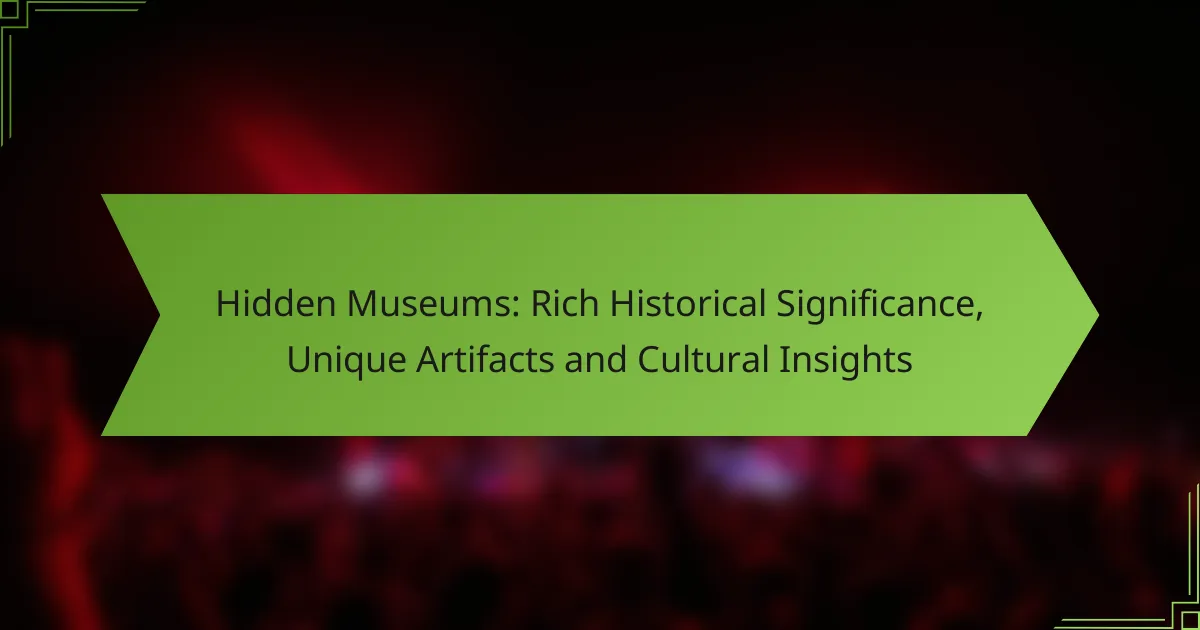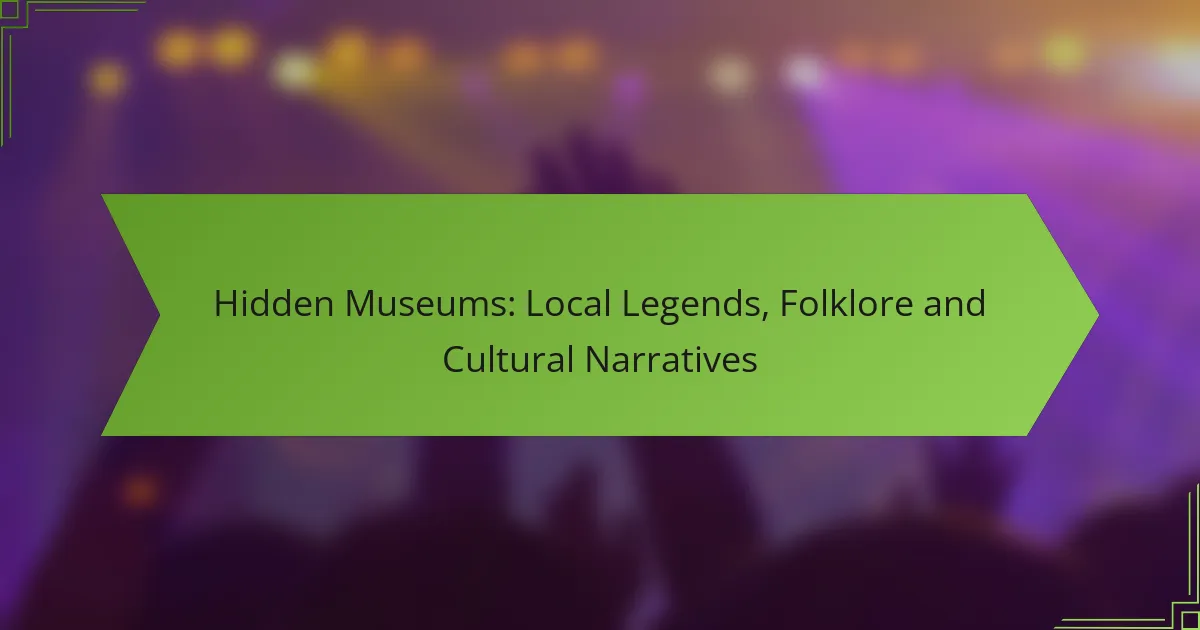Hidden museums in the US offer a treasure trove of unique artifacts and rich historical narratives that are often overlooked by the mainstream. These lesser-known institutions provide invaluable cultural insights, showcasing diverse histories and local heritage that challenge conventional perspectives. By visiting these museums, individuals can engage deeply with the stories and artifacts that shape our understanding of various communities.
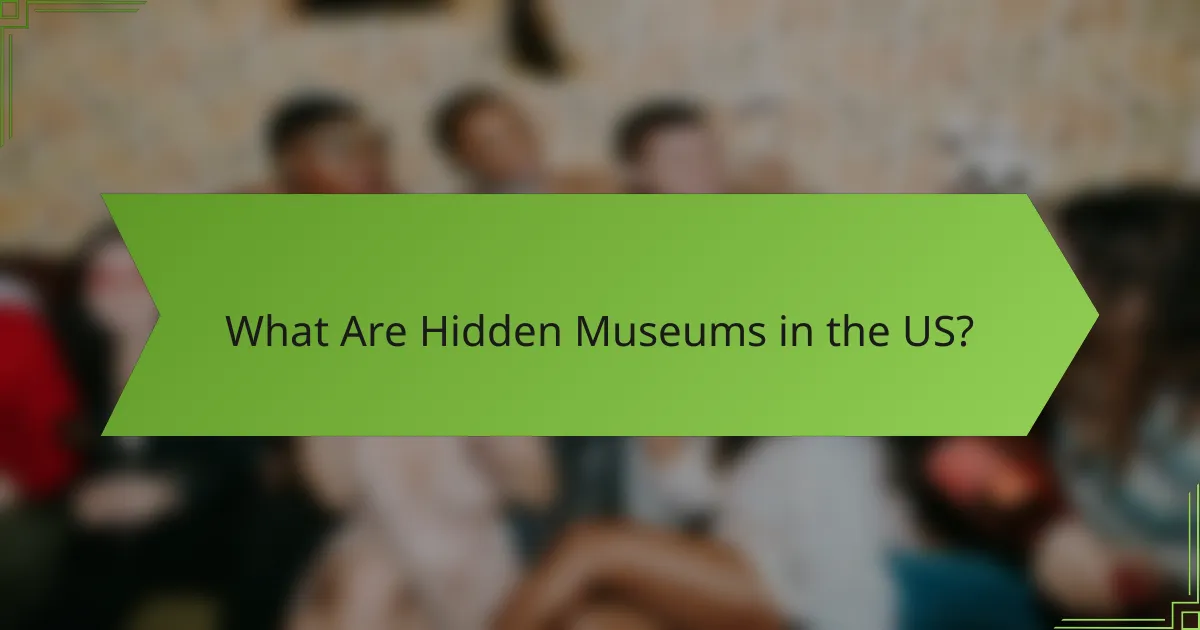
What Are Hidden Museums in the US?
Hidden museums in the US are lesser-known institutions that house unique collections and artifacts, often overlooked by the general public. These museums provide rich historical insights and cultural experiences, showcasing items that tell important stories about local heritage and niche interests.
Definition of hidden museums
Hidden museums are typically small, privately owned, or specialized institutions that focus on specific themes, topics, or collections. Unlike larger, more prominent museums, they may not be widely advertised or easily accessible, often requiring visitors to seek them out intentionally.
These museums can range from quirky collections in basements to dedicated spaces that preserve and exhibit local history, art, or science. Their intimate settings often allow for a more personal connection with the exhibits.
Examples of hidden museums
Some notable examples of hidden museums in the US include the Museum of Jurassic Technology in Los Angeles, which blends art and science in unconventional ways, and the International Cryptozoology Museum in Portland, Maine, dedicated to the study of hidden or undiscovered animals.
Other examples include the American Museum of Magic in Marshall, Michigan, which showcases the history of magic and illusion, and the National Museum of Funeral History in Houston, Texas, which explores the cultural aspects of funerals and memorials.
Importance of hidden museums
Hidden museums play a crucial role in preserving local culture and history, often highlighting stories and artifacts that larger institutions may overlook. They provide opportunities for community engagement and education, fostering a deeper understanding of specific subjects.
Visiting these museums can offer unique insights and experiences that differ from mainstream attractions, encouraging curiosity and exploration. They often serve as a reminder of the diverse narratives that contribute to the broader tapestry of American culture.
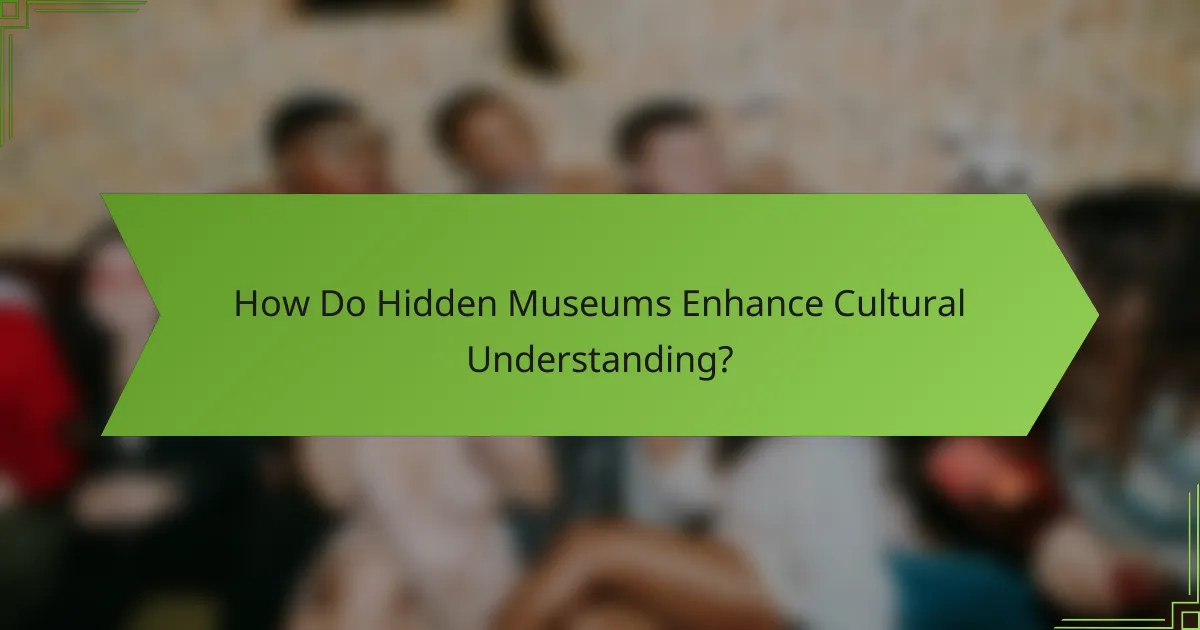
How Do Hidden Museums Enhance Cultural Understanding?
Hidden museums play a vital role in enhancing cultural understanding by showcasing lesser-known artifacts and narratives that reflect diverse histories. These institutions often provide unique perspectives that challenge mainstream cultural narratives, allowing visitors to gain deeper insights into various communities and their heritage.
Unique artifacts in hidden museums
Hidden museums often house unique artifacts that are not typically found in larger, more prominent institutions. These items can include local crafts, historical documents, and personal belongings that tell the stories of specific communities or events. For example, a small museum in a rural area might display tools used by local artisans, offering a glimpse into traditional craftsmanship.
Visitors can encounter artifacts that span various cultures and time periods, providing an opportunity to appreciate the diversity of human expression. These unique items can spark curiosity and encourage further exploration of cultural histories that may not be widely recognized.
Cultural insights from hidden museums
Hidden museums offer valuable cultural insights by presenting narratives that are often overlooked in mainstream discourse. They can highlight the experiences of marginalized groups, showcasing their contributions to society and the challenges they have faced. This can foster empathy and a greater understanding of cultural complexities.
Additionally, these museums often host community events and educational programs that engage local populations. Through workshops, lectures, and exhibitions, visitors can learn about the significance of the artifacts and the stories behind them, enriching their appreciation for cultural diversity.
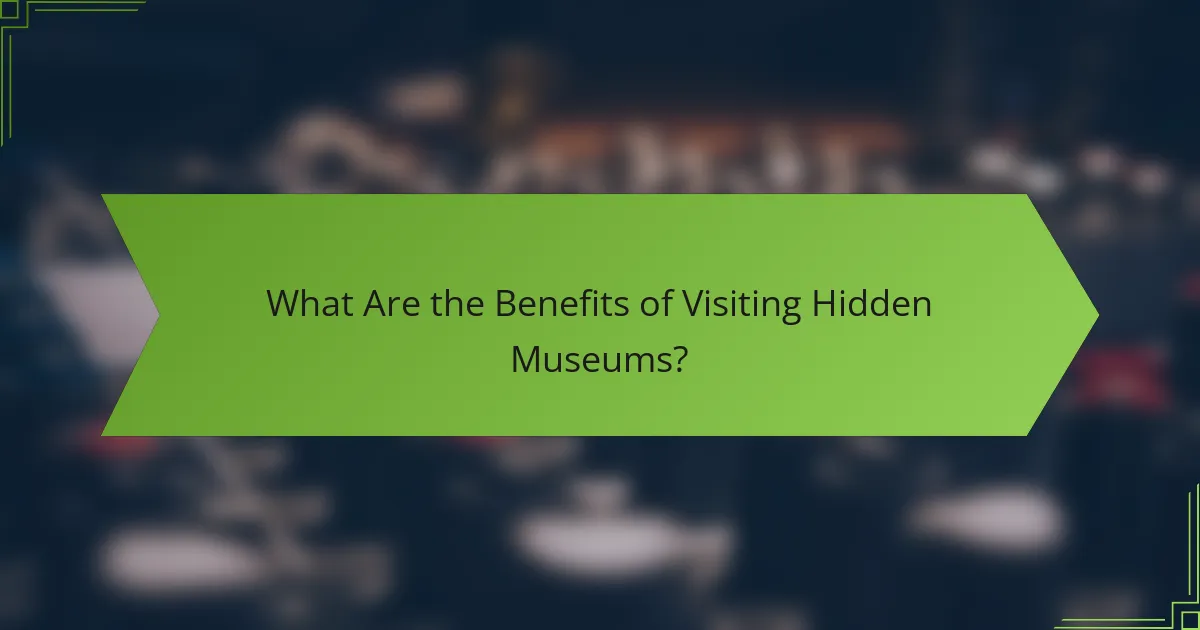
What Are the Benefits of Visiting Hidden Museums?
Visiting hidden museums offers unique insights into local culture and history, often showcasing artifacts and narratives that mainstream institutions overlook. These museums provide a more intimate experience, allowing visitors to engage deeply with the exhibits and the stories behind them.
Educational value
Hidden museums often focus on niche topics or local history, providing educational experiences that differ from larger, more general museums. They may feature specialized collections, such as local art, historical artifacts, or unique cultural practices, which can enhance understanding of a region’s heritage.
For example, a small museum dedicated to a specific craft or trade can offer workshops and demonstrations, allowing visitors to learn hands-on skills and appreciate the intricacies of the craft. This direct engagement fosters a deeper connection to the subject matter.
Support for local communities
Visiting hidden museums contributes to the economic and cultural vitality of local communities. These institutions often rely on community support, and visitor attendance can help sustain their operations, allowing them to continue preserving and showcasing local history and culture.
Additionally, many hidden museums collaborate with local artisans and historians, providing a platform for them to share their work and stories. This not only enriches the visitor experience but also strengthens community ties and promotes local pride.

How to Discover Hidden Museums Near You?
To discover hidden museums near you, start by exploring local resources and online platforms that specialize in lesser-known cultural sites. These museums often showcase unique artifacts and provide rich historical insights, making them worthwhile destinations for enthusiasts.
Online resources for finding hidden museums
Numerous online platforms can help you locate hidden museums. Websites like Atlas Obscura and local tourism boards often feature curated lists of off-the-beaten-path museums. Social media platforms, particularly Instagram and Facebook, can also reveal hidden gems through user-generated content and recommendations.
When using online resources, consider checking reviews and ratings to gauge the quality and significance of the museums. Look for blogs or articles that highlight personal experiences, as these can provide valuable insights into what to expect during your visit.
Local guides and apps
Local guides and mobile apps are excellent tools for discovering hidden museums. Apps like Eventbrite or Meetup often list unique cultural events and exhibitions that may lead you to lesser-known museums. Additionally, local guidebooks can offer detailed descriptions and historical context for these sites.
Engaging with local historians or cultural groups can also enhance your search. They often have insider knowledge about small, community-run museums that may not be widely advertised. Don’t hesitate to ask locals for their recommendations, as they can point you to hidden treasures in your area.
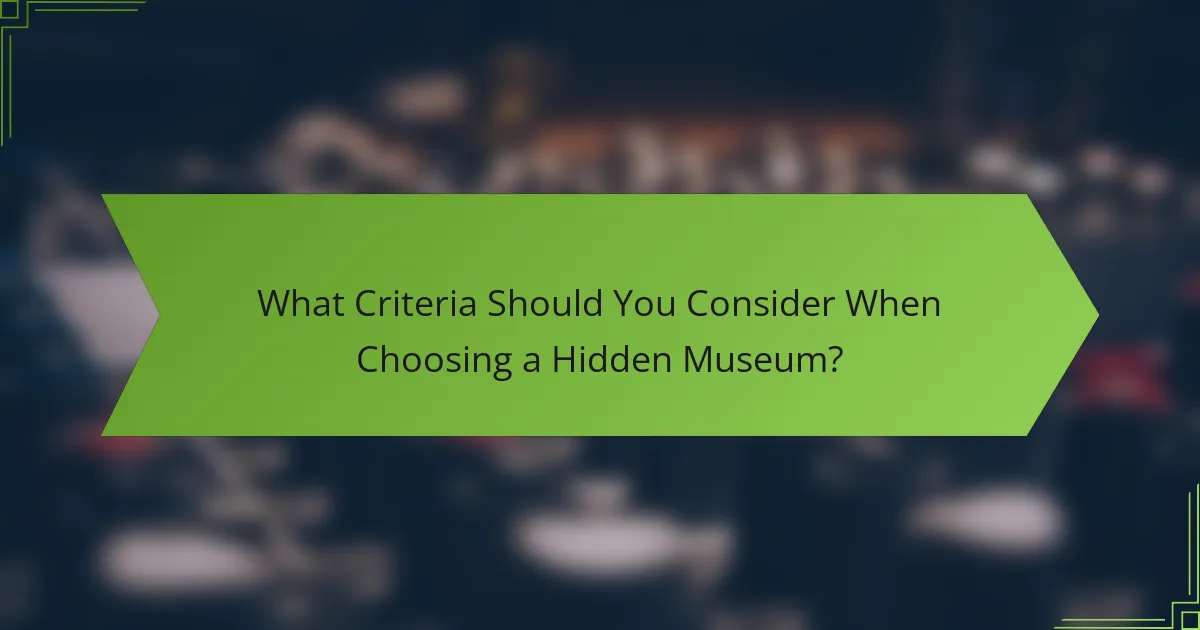
What Criteria Should You Consider When Choosing a Hidden Museum?
When selecting a hidden museum, consider factors such as accessibility, location, exhibit quality, and the uniqueness of the artifacts. These criteria will help ensure a rewarding experience that offers both cultural insights and historical significance.
Accessibility and location
Accessibility is crucial when choosing a hidden museum. Look for locations that are easy to reach by public transport or have ample parking options. Consider the museum’s hours of operation and any potential entry fees, as these can vary widely.
Location also plays a significant role in your experience. Museums situated in less touristy areas may provide a more intimate setting and less crowded viewing. Research the surrounding neighborhood to find dining options or other attractions that can enhance your visit.
Exhibit quality and uniqueness
The quality of exhibits is essential when evaluating a hidden museum. Look for institutions that showcase rare artifacts, rotating exhibitions, or unique collections that are not commonly found in larger museums. This can include local history, specialized themes, or unconventional art forms.
Additionally, consider the storytelling aspect of the exhibits. Museums that provide engaging narratives or interactive displays can significantly enhance your understanding and appreciation of the artifacts. Check reviews or online resources to gauge the experiences of previous visitors regarding the exhibit quality.

What Are Some Notable Hidden Museums Worldwide?
Hidden museums are lesser-known cultural institutions that often house unique artifacts and provide deep insights into local history. These museums can offer a more intimate experience compared to larger, mainstream museums, showcasing collections that reflect the rich tapestry of human culture.
Hidden museums in Europe
Europe is home to numerous hidden museums that reveal fascinating aspects of its diverse cultures. For instance, the Museum of Broken Relationships in Zagreb, Croatia, features personal items from failed relationships, each accompanied by a story. This unique concept invites visitors to reflect on love and loss in a deeply personal way.
Another notable example is the Micropia in Amsterdam, Netherlands, which focuses on the microscopic world. This museum showcases microorganisms and their role in our lives, providing an educational experience that is both engaging and enlightening.
Hidden museums in Asia
Asia boasts a variety of hidden museums that highlight its rich cultural heritage. The Sulabh International Museum of Toilets in New Delhi, India, presents the history of sanitation and toilet technology, emphasizing the evolution of hygiene practices over the centuries. This quirky museum offers a unique perspective on societal development.
In Japan, the Cup Noodles Museum in Yokohama celebrates the invention of instant noodles. Visitors can learn about the history of this popular food, participate in interactive exhibits, and even create their own custom cup noodles, making it a fun and educational experience for all ages.
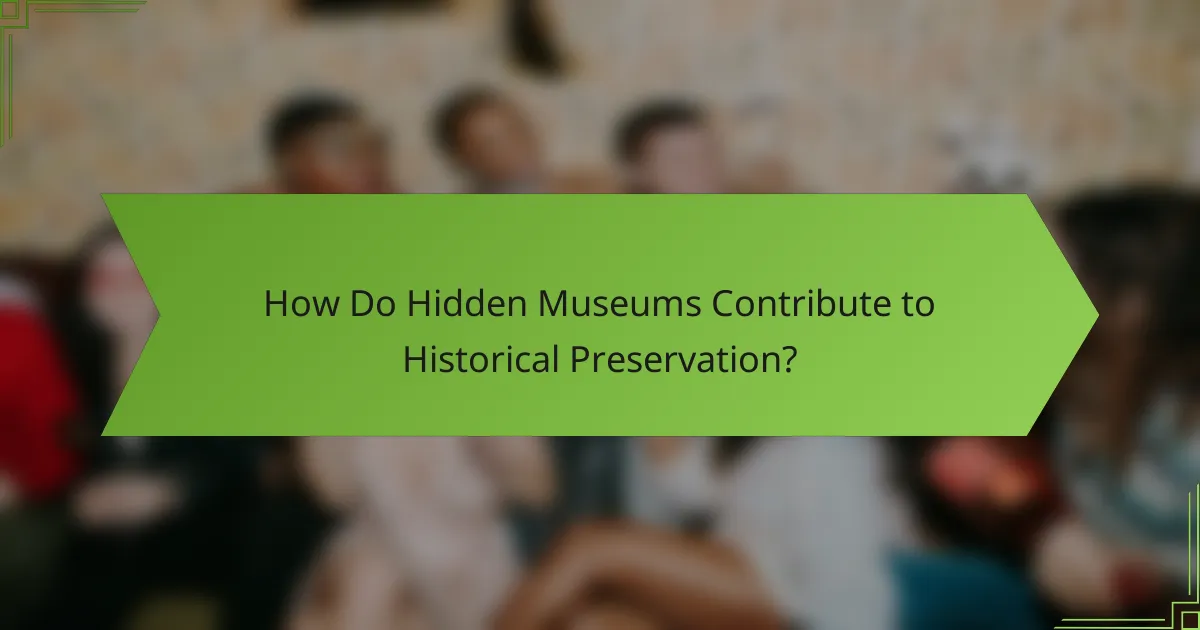
How Do Hidden Museums Contribute to Historical Preservation?
Hidden museums play a crucial role in preserving history by safeguarding unique artifacts and local narratives that might otherwise be overlooked. They often focus on specific themes or communities, ensuring that diverse cultural insights are maintained for future generations.
Role in preserving local history
Hidden museums often serve as custodians of local history, showcasing artifacts that reflect the unique heritage of their communities. These institutions collect and display items that tell the stories of local events, traditions, and notable figures, providing a tangible connection to the past.
For example, a small museum in a rural town might feature artifacts from the area’s agricultural history, including tools, photographs, and personal accounts from local farmers. This focus helps preserve the community’s identity and fosters a sense of pride among residents.
Collaboration with historians and archaeologists
Many hidden museums collaborate closely with historians and archaeologists to enhance their collections and ensure accurate representation of historical narratives. These partnerships often lead to the discovery of new artifacts and the development of educational programs that engage the public.
Such collaborations can involve joint research projects, where museums provide access to their collections for academic study, or community archaeology initiatives that encourage local involvement in uncovering historical sites. This synergy not only enriches the museum’s offerings but also promotes a deeper understanding of the region’s history.

What Are Emerging Trends in Hidden Museums?
Emerging trends in hidden museums focus on enhancing visitor engagement and accessibility while showcasing unique artifacts and cultural insights. These trends include the use of technology, community involvement, and innovative exhibition strategies to attract diverse audiences.
Increased Use of Technology
Hidden museums are increasingly adopting technology to create immersive experiences. Virtual reality (VR) and augmented reality (AR) are being utilized to bring artifacts to life, allowing visitors to interact with exhibits in new ways. For example, a hidden museum might offer a VR tour that transports visitors to historical events related to its collections.
Moreover, mobile apps are becoming common, providing visitors with additional information and interactive features. These apps can include audio guides, scavenger hunts, or augmented reality experiences that enhance the exploration of the museum’s unique artifacts.
Community Engagement and Collaboration
Many hidden museums are prioritizing community involvement by collaborating with local artists and historians. This approach not only enriches the museum’s offerings but also fosters a sense of ownership among community members. For instance, a museum might host workshops where local artisans create pieces inspired by the museum’s collections.
Additionally, outreach programs are being developed to attract underrepresented groups. By hosting events and exhibitions that reflect the community’s diverse cultural backgrounds, these museums can create a more inclusive environment that resonates with a broader audience.
Innovative Exhibition Strategies
Hidden museums are experimenting with innovative exhibition strategies to keep their displays fresh and engaging. Rotating exhibitions allow for the frequent introduction of new artifacts, keeping the experience dynamic for repeat visitors. This strategy can also highlight different cultural narratives and historical perspectives.
Pop-up exhibitions and themed events are becoming popular, providing unique experiences that draw in visitors. For example, a hidden museum might host a temporary exhibit focused on a specific cultural festival, complete with interactive activities and workshops that educate visitors about the significance of the event.
